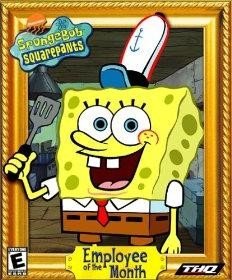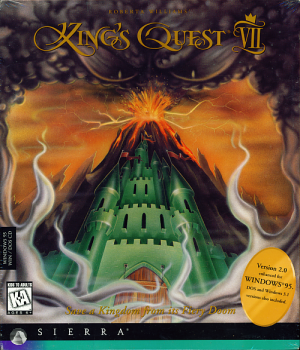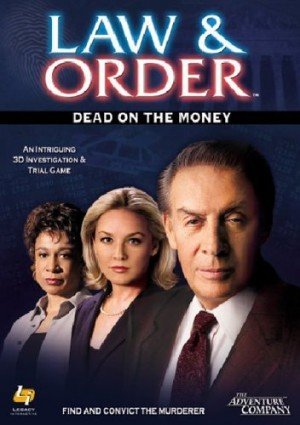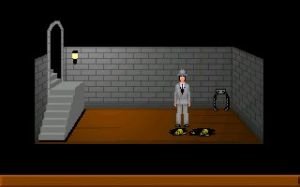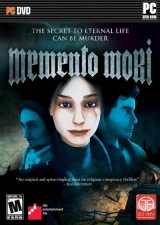Review for CSI: Hard Evidence
Fans of the TV crime series CSI know what to expect every time they watch the show. Most episodes stick to a long established format slavishly: a main case and a subplot, with six forensic investigators somehow managing to cover every major infraction of the law in the entirety of Las Vegas. Followers of the CSI games have found themselves in precisely the same situation, and will do so again as they play through the new instalment, Hard Evidence. Everything you’d expect is here, with no upsets, or, for that matter, pleasant surprises to speak of.
To wit: the player, as themselves, are cast as the newest investigator to join the CSI team, then dispatched to solve a series of five cases, the last of which has some links to one or more of the others. The gameplay consists almost entirely of scouring each crime scene for evidence, selecting the correct tool to detect or collect it, then “processing” it in the lab, which normally constitutes matching the evidence to another specimen or a sample from a database, plus interviewing suspects until one of them is demonstrably guilty. In this fashion, the game does an admirable job of mimicking the show.
Similarly, the game also looks and sounds like CSI, with much of the show’s music and trademark extreme close-ups of forensic procedures making the jump to interactive form literally intact; many clips are cannibalised from the show itself. Most of the television cast lend their voices here and partner up with the player for each case, replete with plenty of “criminal” puns about the current investigation, and their character models are some of the most detailed and well crafted elements of the game’s graphics.
In other respects, the game’s general appearance is perfectly acceptable, but hardly stunning. As in the previous installment, the game is in real-time 3D, but it doesn’t match up to the gloss of many current games. Perhaps to make sure it runs on as many systems as possible, the polygon counts are rather low; outside locations in particular suffer from the simplicity (especially the dated attempt at a water effect). The inherently simpler geometry of the interiors fare much better, letting the artists' craftsmanship come to the fore.
Its presentation feels authentic, then, but does the game play right? The short answer is, it plays simply. Although Telltale Games, at the helm of their second consecutive CSI title, have made a few minor additions to the formula, Hard Evidence feels very much like the first game in the series (released a surprisingly short four years ago). Even the jump to 3D, first introduced in 3 Dimensions of Murder, makes very little difference in gameplay terms, as the only real consequence is eliminating the irritating pixel hunting that plagued the first three games, thanks to the higher resolutions and controllable camera movement that provides a better view of obscured objects.
Each case is a strictly linear affair, and with little puzzle solving to speak of, you won’t get much of a feeling of accomplishment. Searching for evidence is a simple test of observation. The controls never allow you to freely explore each environment, and almost all evidence is in plain view, leaving an inescapable feeling that you’re looking at stage sets, not visiting locations, even moreso than simply watching the TV show. This feeling of disconnect is what permeates the game, and although the problem may at first appear a lack of difficulty (most players will sail through the majority of the five two-hour episodes) it’s more a lack of agency. With no real puzzles, choices, or even possibility of setbacks, it’s hard to feel like a crime scene investigator. It’s telling that the most significant new gameplay advance from the previous game is the bizarre side-task of collecting insects for entomologically-obsessed supervisor Gil Grissom.
There is really no sense of pressure in the investigation, either, as suspects will never work against you to hide evidence very effectively, although about once every case you’ll have to move something to reveal new items. Further simplifying matters, there is no risk of compromising evidence (thus making it harder to solve the case), or tipping your hand too early to a suspect. No, the key to this game is generally clicking on everything, with little thought or planning. Even selecting which of your arsenal of collection (tweezers, gloves, adhesive tape, etc.) and detection (camera, fingerprint powder, luminol...) tools you want to deploy is extremely streamlined; the hardest difficulty setting only provides half a dozen options to choose from, and there are no consequences for selecting incorrectly.
On the rare occasions the designers chose to subvert the format or put a non-standard challenge in place, like creatively using a miniature golf course to uncover evidence, you’ll feel a little surge of joy. In fact, with so many suspicious items typically in plain view, you’ll wonder why the CSIs need to acquire all the warrants that act as an overused device for pacing each episode. At one point, the repetitive warrant process requires you to revisit the car of a suspect three separate times -- a suspect just taken into custody for leading the police on a high speed pursuit after a brutal murder. For glamorous fictional detectives, these CSIs seem bound to a worrying extent by red tape. No one expects slavish accuracy in such romanticised depictions of forensics, but some grip on reality would be nice.
When the complexity of the game has been upped, even slightly, it’s a blessing. Take the jigsaw-style task of putting pieces of a torn photo together; now that pieces can be flipped and rotated it starts to feel less like busy-work and more like a challenge, although still hardly a difficult one. The fingerprint matching task has also been slightly upgraded, as now partial prints can be overlayed by placing them in four “quadrants” of a full print. It’s not quite overlaying it yourself, rotating it and resizing it to match print to print (all of which are, of course, not just the same whorls and ridges, but identical down to the last pixel), but it is getting there. A similar situation occurs with the video analysis tools. Selecting the crucial frame in a sequence for some mystical “computer enhancement” process that reveals new details is all well and good, but unless the player is expected to highlight the precise area of interest (just like in the show) there’s no reason why a little trial and error can’t solve the puzzle just as fast.
This refusal to take a leap into something more ambitious is what holds Hard Evidence back, and the CSI series in general. All the advanced press release talk about new techniques and tools is very much marketing speak for having little evolution in the core gameplay. You’ll mostly notice just some slight and hardly necessary streamlining. There are, as usual, ways of making the game superficially harder; but this is done mainly by removing useful features like evidence tagging without introducing any more depth.
Having said all that, these criticisms make the game sound a good deal less entertaining than it actually is. Firstly, it’s refreshing to play an adventure in real-time 3D, even if it relies on fixed camera positions and very little interaction. Just being able to rotate around areas to spot clues makes finding them more fun than looking for pixels on a pre-rendered background. Then there’s the writing. Each of the cases is a good old-fashioned mystery with lots of twists and turns to uncover as you slowly unpick the story. They do feel a tad lazier than Telltale’s debut though: identical siblings, a lesbian couple and a blind woman are used as blatant ways to add a unique element to cases, the latter providing some of the more tasteless of the aforementioned quips from the cast. Thankfully, such quibbles are the exception rather than the rule, and the voice acting lives up to the quality of the writing for most characters.
Despite some clever location and model re-use, each of the five incidents forms a satisfying standalone case. There is, however, an absence of anything as knowing or as playful as 3 Dimensions of Murder’s case set at an in-joke-laden gaming trade show. The ending case, furthermore, doesn’t cleverly incorporate the four previous cases, just one, and as a result feels a little less impressive than it should. There’s also some very odd product placement; there is nothing objectionable (and in fact it rather adds to the authenticity of the world) about characters driving real cars or using real PDAs, but quite why a major credit card company wants adverts boasting about its security features on a burnt-out taxi cab or on the billboard next to a run-down alley is perhaps the biggest mystery of all.
The CSI games have become better in recent outings, but ultimately this title feels a lot like treading water, and in some respects, a small regression from the last game. With few new additions, increasingly dated graphics, and gameplay still in dire need of a little more substance, you’ll likely be entertained by the latest CSI, but not enthralled. Making the game easy and simple to play is understandable, as it's designed to appeal to fans of the show, not gamers. But it’s quite possible to have simplicity and depth, and the latter is once again missing in Hard Evidence. There's some effortless enjoyment to be found here, then, but until Ubisoft (or their CBS overlords) is prepared to take a few creative risks with the franchise, players will continue to feel as if they’re watching the CSIs, not being one.
So that's the PC review. How did the Nintendo Wii port fare several months later? Read on to find out!
Nintendo Wii port
When the Nintendo Wii was first revealed to be remote-driven with a heavy emphasis on motion-sensing technology, the possibilities for a resurgence of adventures on home consoles seemed promising. After all, not only is the Wii controller ideal for simple point-and-click mechanics in a way that gamepads are not, but the notion of introducing a new level, new form of physical interaction to a largely passive experience seemed like just the kind of innovation that the genre sorely needs to be relevant beyond the diehard adventure community.
It took a while for any adventures to appear on the system, but now the early results have started to trickle in. One of the initial ports of existing games is CSI: Hard Evidence, and while the game proves a generally competent conversion of its PC forebear, it also demonstrates the limitations of playing it a little too safe.
The fourth adventure starring the CSI crew from Las Vegas, Hard Evidence stays devotedly true to the formula laid down by its predecessors, somewhat to its detriment. The criticisms of the original PC release were based not so much on failings of the game itself as on the stubborn resistance against moving the series forward in any significant way. In that sense, a Wii port of the game could have been the perfect chance to finally freshen up a series quickly going stale. In saying "could have", of course, the logical (and correct) conclusion is that it doesn't.
Perhaps going the safer route is the best decision for this particular game on the Wii, mind you. After all, the CSI series is designed with casual gamers in mind, and Hard Evidence is the series debut on a unique system itself designed to appeal to casual gamers. It's only natural to think that the goal is simply reaching a whole new market of casual gamers from the millions of TV CSI fans, cautiously avoiding the pitfalls of excessive ambition and potentially intimidating motion controls. The voices of the disgruntled PC hardcore are muted here, and the game's unflinching similarity to previous titles irrelevant.
Indeed, if this is your first exposure to the CSI adventures, there is much to like about the game on a fairly superficial level, unencumbered as you'll be without prior expectations. Not only is it a faithful port of its point-and-click counterpart, but with few exceptions, a fairly flawless one. The character models look even blockier than I remember, the lower resolution results in some pixel hunts at times, the voiceovers will stutter occasionally, and the load times are longer than I'd have liked, but in all other respects, there is very little difference of note between original and port other than its platform. No content corners have been cut, the game is still fully voiced (mostly by the cast of the television show), and if not for holding a remote instead of a mouse, you'd barely notice a difference in controls.
Now, having said that – you knew there was a "but" coming, right? – there's no getting around the fact that this is about as uninspired a port as possible. Yes, it's exactly like the PC version in all material ways, but that's not an inherently good thing. I mean, a Wii game with no motion controls at all? What the heck! If nothing else, the central activity of using the many forensic tools is ideally suited to a basic level of hands-on interaction, but Hard Evidence doesn't even go there. Need to dust a surface for fingerprints? Surely that's a tailor-made demand for some remote-sweeping motions to simulate the dusting action. But no. Here you'll hold down a button and watch the duster automate itself. That's just one example, but the bigger point is that there are no examples to counter it, forsaking even the most obvious opportunities to capitalize on the Wii's most distinctive feature.
The end result, then, is a routine point-and-click adventure on Wii – nothing more and nothing less. If you've already played the PC version, there is absolutely no reason to revisit the game. Even the "extras" provided for completing the five cases and meeting the highest performance goals are identical, and they were pretty lame to begin with. Replayability and thoroughness bonuses are common features of video games but never a strength of adventures, so this game faced an uphill battle in that regard. Hard Evidence does make an effort, but it'll take more than a few concept sketches and game trailers to entice anyone to spend any longer than the 8-10 hours it'll take to whip through the first time.
Still, the game largely succeeds at what it tries to do, so if you're up for a lightweight mystery adventure and have a Wii in your household, Hard Evidence may just be the excuse you're looking for to kick the kids off the TV and grab some gaming time yourself. The port is unquestionably a solid conversion, making the choice of versions a simple matter of system preference. If you've always wanted to be an armchair CSI, now you can actually be one in your coziest armchair if you so desire.











